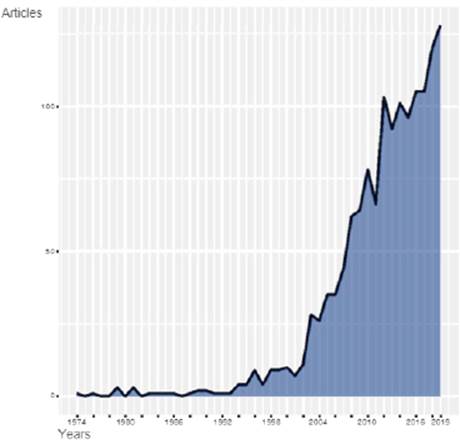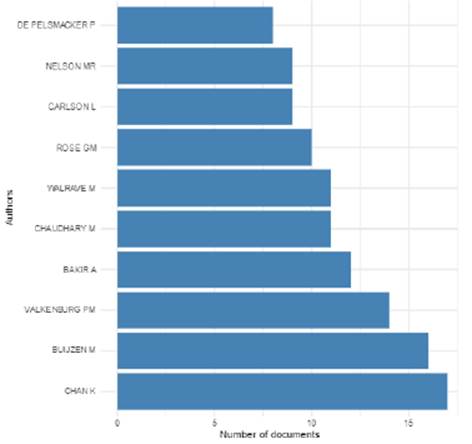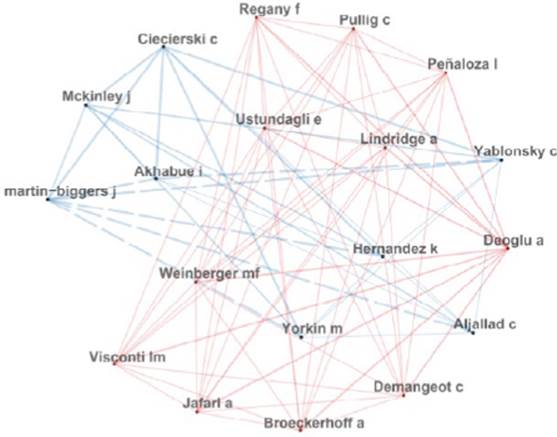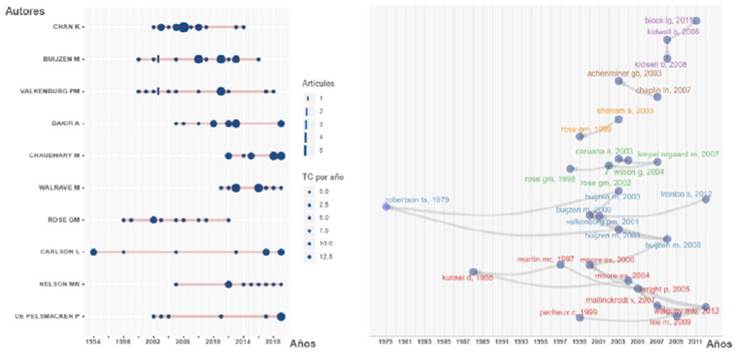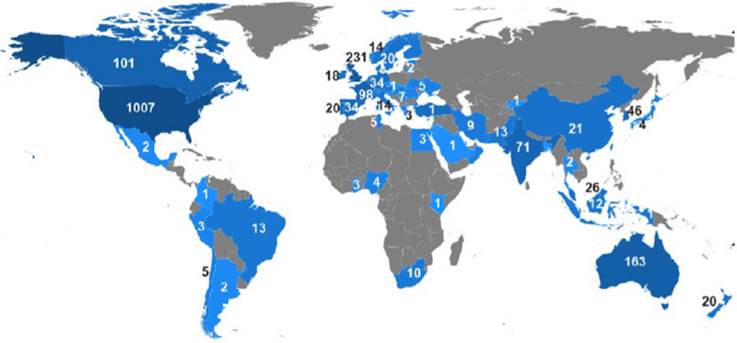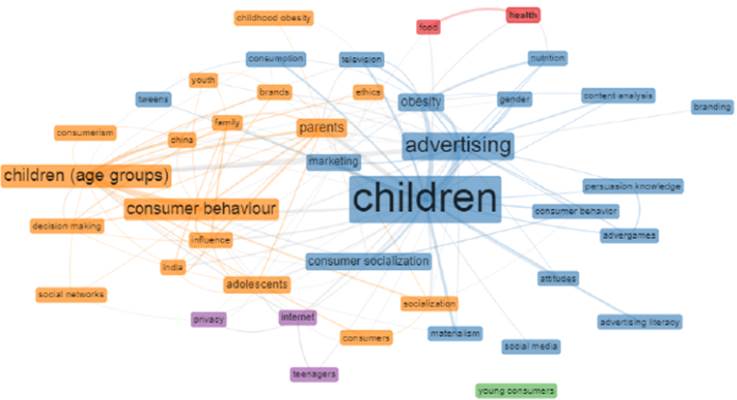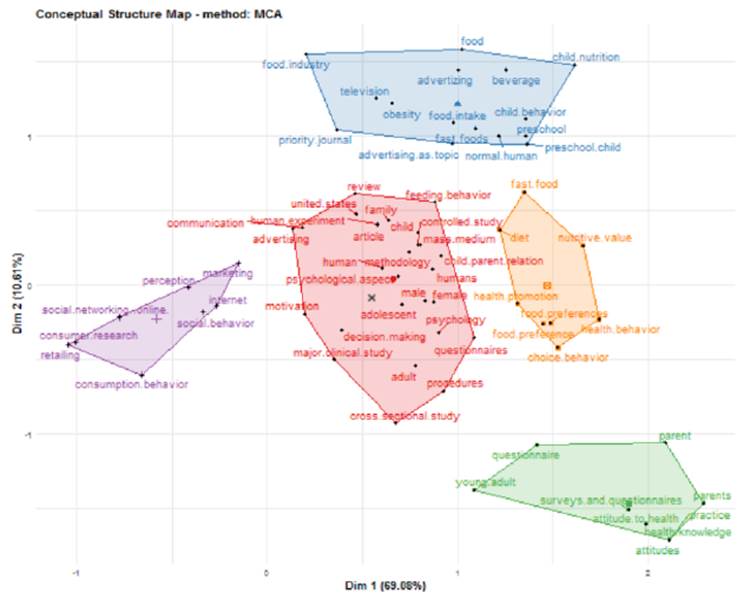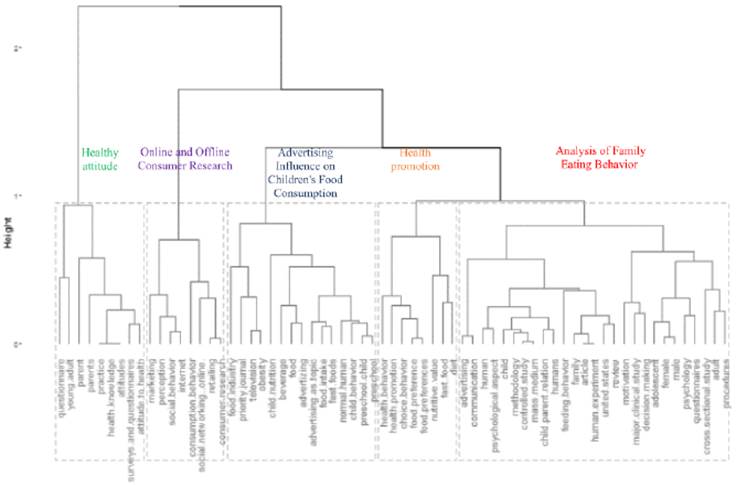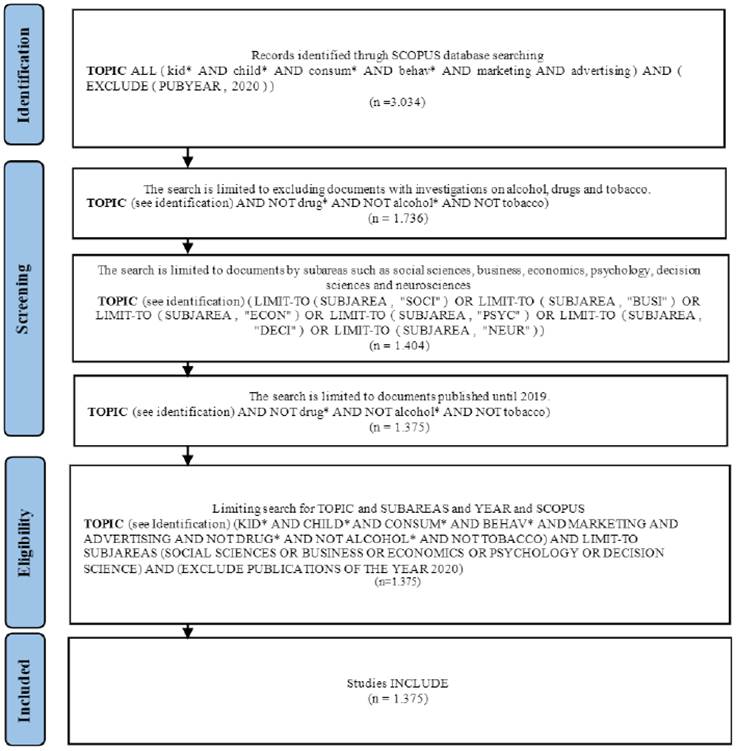Introduction
Consumer studies have concentrated their research on the adult population (Baumgartner, 2010; Fetscherin et al., 2019; Jia et al., 2018; Pinzón & Pérez-Acosta, 2020), due to their immediate relationship with the choice of products and the commercial transaction. However, there is a growing interest from various academic and business organizations to deepen their understanding of psychological processes and behavior patterns of the child population in terms of product consumption. Research on brand loyalty and children's conspicuous consumption dates back to the 1950s and it was not until the mid-1970s that this field of study gained visibility in the marketing community. Currently, the study of the child population behavior is considered central for the development of marketing strategies, communication and social programs (Barriage et al., 2017; John, 1999).
On the other hand, social marketing aimed at the child population shows evidence of positive impact on this population, favoring practices related to physical exercise, so it can contribute to the development of healthy habits (Bagramian et al., 2019; Deshpande et al., 2015: Schuster et al., 2015), not only based on communication strategies, but also from the families approach, in whose context various decision patterns and choice of products and services are modeled and reinforced (Aleti et al., 2015). This vision of marketing is socially fundamental, because it regulates and promotes social ties, healthy behavior patterns, responsible and empathic actions with other people and with the environment. It serves as a regulating factor of advertising content and marketing actions that seek to increase consumption by influencing their behavior in stores or commercial surfaces (Martin-Biggers et al, 2013), on television, (Calvert, 2008: Effertz & Wilcke. 2012). in online environments (where they face various risks) (Kennedy et al., 2019) and in video game environments (Sáleme et al., 2020).
Children assume a user role, benefiting from the products that third parties purchase for them: however, as consumers, children can play roles of users and influencers, depending on the preference for brands and the level or degree of dominance over their parents, directing the choice of products at the time of purchase. Now, in contexts where this population has economic resources and the functional atmosphere or environment facilitates the acquisition of products, children assume the roles of buyers and users, carrying out a process of selection and commercial transaction to stock up on products to supply themselves with products that meet the needs they consider important, based on their cognitive development and the particular characteristics associated with their age (Ortegón Cortázar et al., 2015; Rohde & Mau. 2021).
In general, it is possible to affirm that there is a relationship between child development and the interaction they have with brands (Ortegón Cortázar et al., 2015: Royo Vela & Ortegon-Cortázar, 2019). Understanding these interactions is essential for the advertising communication that brands create, offering a fundamental heritage hi understanding the phenomenon of brand learning (Sandoval-Escobar et al., 2018). Due to the great importance of child consumption, there are different lines of work in addressing this topic in consumer psychology. Traditionally, these investigations are oriented to the impact of the family on consumption habits (Geuens et al., 2003), nutrition (Collins et al., 2014: Koplin et al., 2019; Pries et al., 2019), the consumption of alcoholic beverages (Seilhamer et al., 1993), drugs and tobacco (Nunez-Smith et al., 2010), with a great diversity of findings, models, and results. However, no studies have been identified that have described the areas of inquiry, the groups that carry out these works, the corresponding disciplines and the most important findings that account for the psychological processes involved hi child consumption and their relationships with the consumption of brands (Bucher et al., 2016).
Thus, the present systematic bibliometric study aimed to identify and analyze the lines and areas of research hi relation to children's consumption, to establish which are the most important publications, authors and trends in this field of research within the period from 1974 to 2019. For this purpose, only scientometric indicators resulting from the search of articles hi a database were used, with terms associated with marketing and child consumer psychology, from a psychological, economic and social perspective.
Method
Units of Analysis
A systematic bibliometric analysis (Alia & Cuccurullo. 2017) was performed to investigate and evaluate the lines and areas of inquiry in psychology, behavior, and social marketing, in relation to child consumption. The articles analyzed were the result of a search hi the database Scopus -Elsevier B.V. The search strategy used was as follows: ALL (kid* AND child* AND consum* AND behav* AND marketing AND advertising AND NOT drug* AND NOT alcohol* AND NOT tobacco) AND (LIMIT-TO (SUBJAREA. "SOCI") OR LIMIT-TO (SUBJAREA. "BUSI") OR LIMIT-TO (SUBJAREA, "ECON") OR LIMIT-TO (SUBJAREA, "PSYC") OR LIMIT-TO (SUBJAREA, "ECON”) OR LIMIT-TO (SUBJAREA, "NEUR")) AND (EXCLUDE (PUBYEAR. 2020)). To report the results of the search, the PRISMA2020 flowchart for new systematic reviews that included searches in databases was used (Page et al., 2021) hi Appendix A, taking as reference the report of Fortuna (2020). The results of this analysis were downloaded on February 10.2020. The time span of the search begins in 1974 and ends in 2019. 1,375 articles were analyzed, from 703 journals, 192 books, 119 book chapters, 74 literature reviews, 966 articles and two articles hi press, two editorial notes and three editorials, 2588 author keywords, 1265 additional keywords were included; the average of citations per article was 23.89, with 2597 authors of whom 344 published alone and 2553 did it jointly with other authors.
To estimate that the distribution of the data associated with the result of the query had a distribution without difference with the frequency of publications, the Lotka function was used. (Pao. 1985) This estimates the coefficients for scientific productivity associated with the frequency of authors' publications in a field of knowledge, where the number of authors who publish a certain number of articles is a fixed proportion with respect to the number of authors who publish a single article. This assumption implies that the theoretical beta coefficient is an inverse relation to the square of Lotka's law. In this way, it can be determined whether there are differences between the result of the bibliometric data with respect to the theoretical distribution. This bibliometric s has an estimated Beta coefficient of 2.81 with a goodness of fit equal to 0.95. The Kohnogorov-Smirnoff test gives a p-value of 0.09. indicating that there is no significant difference between the theoretical data and the Lotka distributions from this study (Sahu& Jena. 2021).
Instrument
The Bibliometrix tool was used (The R Project for Statistical Computing). This instrument offers a set of tools for the quantitative investigation of textual data, converting information from databases represented by variables such as title, authors, keywords, publications, journals, citations and various scientometrics data resulting from a formula or search strategy in databases such as Scopus. Web of Science. Cochrane, PubMed and Dimensions.
Procedure
The result of the article search, according to the previously defined criteria, was exported including information such as citation data, bibliography, abstract, keywords, affiliations, and references within a BibTeX file. The data were first analyzed from descriptive criteria related to the number of publications, total number of authors, number of keywords, and the rate of growth in the scientific production of consumer behavior research: subsequently, the most representative articles on the subject were selected and a qualitative review of their contents and methodologies was carried out.
Results
The result of publications shows peaks of a high number of citations of documents associated with issues of child consumption, for the years 1981. 1992 and 1999. The scientific production in this area of knowledge has a sustained behavior with a growth rate of 11.38 (Figure 1). The average number of articles per author is 0.529. the average co-authorship per article is 2.28 and the average of authors per article is 2.37.
The five most productive countries are the USA (320 articles), the United Kingdom (61 articles), Australia (54 articles), Belgium (27 articles), Canada (25 articles), and the Netherlands (25). The average number of citations by country varies the order in the first five nations: USA (10415), United Kingdom (1940), Australia (956), Canada (676), Hong Kong (596). On the other hand, the country with the largest national and international production hi scientific research related to children's consumers is the United States. The five authors with the highest production of research articles are Chan, K; Buijzen, M; Valkenburg, PM; Bakir, A; Chaudhary, M (Figure 2).
Regarding the most relevant journals by the number of publications in marketing research directed at children's consumers, these were: Young Consumers (35 articles), Journal of Consumer Marketing (12 articles), International Journal of Retail and Distribution Management (9 articles), International Journal of Consumer Studies (8 articles), Journal of Business Research (8 articles).
The five most used keywords (Table 2) are: children (60 articles), children age groups (28 articles), consumer behavior (45 articles), education (25 articles), gender (24 articles). The Bibliometrix analysis highlights the keywords hi two ways : the main one being the general list of the frequency per year of the keywords most used in SCOPUS (keyword expansion) (ID) and the keywords used by each author and associated with the general listing (keywords associated with author) (DE) (Aria & Cuccurullo, 2017). Under the search strategy used, the results are presented hi Table 1.
Table 1 Most important keywords.
| Author's Keywords (ED) | Articles | Additional Keywords (ID) | Articles | |
|---|---|---|---|---|
| 1 | Male | 119 | Feeding behavior | 31 |
| 2 | Female | 115 | Obesity | 51 |
| 3 | Child | 110 | Health promotion | 27 |
| 4 | Human | 92 | Internet | 27 |
| 5 | Humans | 70 | Controlled study | 26 |
| 6 | Adolescent | 60 | Decision making | 24 |
| 7 | Article | 59 | Marketing | 24 |
| 8 | Adult | 51 | Preschool | 22 |
| 9 | United states | 39 | Psychology | 22 |
| 10 | Television | 35 | Young adult | 21 |
Table 2 The 10 most cited articles.
| Articles | TC | TC per year | |
|---|---|---|---|
| 1 | Thrift. N. (2005). Knowing capitalism. Sage. | 804 | 50.25 |
| 2 | Alter. A. L., & Oppenheimer, D. M. (2009). Uniting the tribes of fluency to form a metacognitive nation. Personality and Social Psychology Review, 13(3), 219-235. | 591 | 49.25 |
| 3 | Campbell. M. C. (1999). Perceptions of price unfairness: antecedents and consequences. Journal of Marketing Research, 36(2), 187-199. | 429 | 19.5 |
| 4 | Inkpen, A. C, & Tsang, E. W. (2007). 10 Learning and strategic alliances. The Academy of Management Annals, 1(1), 479-511. | 424 | 19.27 |
| 5 | Wansink. B., & Chandon, P. (2006). Can "low-fat" nutrition labels lead to obesity? Journal of Marketing Research, 43(4), 605-617. | 414 | 27.6 |
| 6 | Anderson. P. M., & Butcher, K. F. (2006). Childhood obesity: trends and potential causes. The Future of Children, 16(1), 19-45. | 358 | 23.86 |
| 7 | Nicholls, A., & Opal, C. (2005). Fair trade: Market-driven ethical consumption. Sage. | 338 | 21.12 |
| 8 | Bendapudi, N., Singh, S. N., & Bendapudi, V (1996). Enhancing helping behavior: An integrative framework for promotion planning. Journal of Marketing, 60(3), 33-49. | 311 | 12.44 |
| 9 | Kumanyika, S., & Grier, S. (2006). Targeting interventions for ethnic minority and low-income populations. The Future of Children, 16(1), 187-207. | 308 | 20.5333 |
| 10 | Alan, B. (2004). The Disneyization of Society. Sage | 308 | 18.1176 |
Regarding the most cited articles. Table 2 indicates the number of citations (TC) and the average number of citations per year (TC per year). These articles with the highest number of citations are of a traditional nature, having as object of study consumption practices in general without an emphasis on the child population (Aria & Cuccurullo, 2017).
Bibliometric results in terms of authors have two categories depending on the indicator applied: the number of articles published in the period and their level of citations within other articles included in the search strategy, which determine productivity. On the other hand, there is a relationship that indicates the fraction of articles written by various authors hi which an academic appears as the first author. This is called the dominance factor (DF) (Kumar & Kumar, 2008) and expresses the degree of mastery of an author in his research group (Table. 3).
| Author | Dominance Factor | Total Articles | Individual Author | Multi-Author | First Author | Position per Articles | Position per DF | |
|---|---|---|---|---|---|---|---|---|
| 1 | Chaudhary M | 0.8571429 | 11 | 4 | 1 | 7 | 6 | 5 |
| 2 | Chan K | 0.7000000 | 17 | 7 | 2 | 10 | 7 | 10 |
| 3 | Bakir A | 0.7000000 | 12 | 2 | 3 | 10 | 7 | 7 |
| 4 | Rose G. M. | 0.5555556 | 10 | 1 | 4 | 9 | 5 | 4 |
| 5 | Buijzen M. | 0.3750000 | 16 | 0 | 5 | 16 | 6 | 9 |
| 6 | Nelson M. R. | 0.3750000 | 9 | 1 | 6 | 8 | 3 | 2 |
| 7 | Walrave M. | 0.3636364 | 11 | 0 | 7 | 11 | 4 | 5 |
| 8 | Valkenburg P. M. | 0.2307692 | 14 | 1 | 8 | 13 | 3 | S |
| 9 | Carlson L. | 0.2222222 | 9 | 0 | 9 | 9 | 2 | 2 |
| 10 | De Pelsmacker P. | 0.1250000 | 8 | 0 | 10 | 8 | 1 | 1 |
The authors' bibliometric parameters are expressed in indices. Table 4 shows the result by H index (Feng et al., 2015). G index (Egghe, 2006) and M index (Choudhri et al., 2015) for the first ten authors in the analysis of the 1375 documents included in this study.
Table 4 Top 10 Indexes per author.
| Author | H_index | G_index | M_index | TC | NP | PY_start | |
|---|---|---|---|---|---|---|---|
| 1 | Chan K | 10 | 15 | 0.5263158 | 246 | 17 | 2002 |
| 2 | Buijzen M | 13 | 16 | 0.6190476 | 831 | 16 | 2000 |
| 3 | Valkenburg PM | 12 | 14 | 0.5714286 | 797 | 14 | 2000 |
| 4 | Bakir A | 6 | 11 | 0.3750000 | 128 | 12 | 2005 |
| 5 | Chaudhary M | 5 | 7 | 0.5555556 | 50 | 11 | 2012 |
| 6 | Walrave M | 8 | 11 | 0.8000000 | 178 | 11 | 2011 |
| 7 | Rose GM | 9 | 10 | 0.3913043 | 331 | 10 | 1998 |
| S | Carlson L | 5 | 9 | 0.1851852 | 145 | 9 | 1994 |
| 9 | Mcneal JU | 7 | 9 | 0.2916667 | 243 | 9 | 1997 |
| 10 | Nelson M | 7 | 9 | 0.4375000 | 219 | 9 | 2005 |
On the other hand, documents can be grouped by bibliographic coupling. In this way. the authors create work networks relating their articles by having references shared hi the bibliography. Hie results show three groups of authors (Figure. 3). In this case, from right to left of the image, there are two groups marked hi blue lines, the first of which is headed by Yablonsky C, followed by Lindrdge A, Ustundagli E, Ciercierski C and McKinlei J. The second group includes Aljallad C, Hernandez K, Yorkin M and Weinberger MF. A common author between these two networks is Martin-Biggers J; her articles are focused on infant feeding, family practices, promotions, and the prevention of obesity. In turn, the works of Martin-Biggers J. are associated with those developed by Byrd-Bredbenner C, who since 2002 investigates eating in a close relationship with children, then behavior and the various factors that impact consumption habits of food, such as advertising, communication, health promotion and social marketing. Professor Carol Byrd-Bredbenner is a seminal author on research related to infant food consumption (Byrd-Bredbenner et al., 2017).
On the other hand, the dynamics in the authors' investigations can be observed from the evolution of their investigations in the number of articles published and the citations for each document, as well as the networks that are woven between the authors over time (Figure 4). As a result of this analysis. Chan K. is the most productive author, with nearly 160 articles. He directs his investigations to the consumption habits of children in China and his research dates from 2002. Later. Buijzen investigates the influence of the advertising on child consumption behavior, followed by Valkenburg (2007), who investigates the effects of social networks, television and advertising on tweens and teens.
Analysis of publications on child consumer behavior in the afore mentioned historical range shows Robertson as an important author (1974), who wrote the article Children and Commercial Persuasion: An Attribution Theory Analysis, one of the mam references in the scientific study of child consumption. However, there are also sets of authors that acquire importance due to their bibliographic coupling, which occurs when the works of a group of authors are published by a journal or magazine. The journal that includes the highest density of topics related to child consumer research is Young Consumer, a British publication belonging to Emerald Group Publishing Ltd., with an H Index of 22, created since 2002 and recently Q1 in the economic miscellany, econometrics and finance. On the other hand, there are orientations adjacent to child behavior in the role of consumer associated with family habits, the influence of advertising communications on product consumption behaviors, the impact of television and social media advertising on the practices of children related to the consumption of brands, and incomplete information in communications in the advertising of baby food, resulting in bad eating habits.
When establishing collaboration among authors' affiliations by country, it is observed that the United States has the highest rate of collaborative work in research on child consumption, followed by the United Kingdom and Australia. The primacy of the North American country is given by a phenomenon of co-authorship in the investigations. This collaboration represents greater productive research activity in the field of child consumption, which is evidenced in the 1007 documents published in the USA, compared to 231 in the United Kingdom and 163 in Australia (Figure 5).
On the other hand, it was found that the co-occurrences of the most used keywords directly related to child consumption are: child, consumer behavior (which, although it is an Anglicism, is used in the British articles), advertising, consumer socialization, and the latter related to obesity (Su & Lee. 2010) (Figure 6). There are direct associations between words like: persuasion knowledge, advergames and children, as well as between advertising literacy, attitudes, and children. but the strongest association is between the words: children, advertising, and obesity.
By observing the analysis of co-occurrences through multidimensional reduction (Aria & Cuccurullo, 2017) the result presents conceptual structures, identifying sets of articles that work on common themes according to the K-means clustering technique (Hartigan & Wong. 1979: Kanungo et al., 2002). Hie results are represented on a two-dimensional map (Figure 7).
For this analysis, five clusters are observed, categorized from the extraction of common terms. From left to right, the first group integrates words such as voting adults, questionnaires, parent(s), healthy attitudes, practices and healthy knowledge, and attitude towards health. The second group gathers words such as consumer behavior, social behavior, marketing, perception, social networks, networking, consumer research and retail. We will call tins group Online and offline consumer research. The third grouping, together with words like fast food, diet, nutritional value, healthy behavior, food preference, food choice, will be called Healthy promotion. For the fourth grouping, the result includes words such as food industry, television, obesity, advertising, food, drink, food consumption, child behavior, preschool and child nutrition. We will call it Advertising influence on children s food consumption. Finally, group five, with the highest coverage hi research, is made up of words such as: advertising, communication, motivation, clinical studies, cross-sectional studies, controlled studies, decision-making, adults, children, adolescents, parent-child relationship, family, psychological aspects, experiments and eating behavior. We will call tins group Family eating behavior (Figure 8).
From the formation of the clusters, each grouping integrates a set of authors and articles and magazines with more citations. It is generally observed that the topics associated with child consumption, which have been researched and published for decades, are mainly related to food consumption and healthy behavior. Next, the most important topics in the field of research on child consumption are analyzed, for which the main authors, the most consulted documents and the journals with the highest relationship with each of the topics identified will be integrated (Table 5).
Table 5 Top 5 documents per cluster.
| Cluster | Authors | Tittle | Journal | Citations | Year |
| Healthy Attitude | Kumanyika | Environmental Influences On Childhood Obesity: Ethnic And Cultural Influences In Context | Physiology and behavior | 205 | 2008 |
| Neff et al. | Food systems and public health disparities | Journal of Hunger and Environmental Nutrition | 63 | 2009 | |
| Cornil & Chandon | Smaller food portions, pleasure as a substitute for size: how multisensory imagery can make people happier with its consumption. | Journal of Marketing Research | 43 | 2016 | |
| Kubacki et al. | A systematic review assessing the extent of social marketing principle use in interventions targeting children (2000-2014) | Young Consumers | 29 | 2015 | |
| Mcalister & Bettina | Collectible toys as marketing tools: understanding preschool children's responses to foods paired with premiums | Journal of Public Policy and Marketing | 27 | 2012 | |
| Frías et al. | Internet vs. Travel agencies on pre-visit destination image formation: an information processing view | Tourism management | 138 | 2008 | |
| Brandtzg | Towards a unified media-user typology (mut): a meta-analysis and review of the research literature on media-user typologies | Computers in human behavior | 96 | 2010 | |
| Online and Offline Consumer Research | Greenfield | Developmental considerations for determining appropriate internet use guidelines for children and adolescents | Journal of applied developmental psychology | 38 | 2004 |
| Seock & Norton | Attitude toward internet web sites, online information search, and channel choices for purchasing | Journal of fashion ting and management marke- | 32 | 2007 | |
| Matusitz & McCormick | Sedentarism: the effects of internet use on human obesity in the United States | Social work in public health | 24 | 2012 | |
| Advertising Influence on Children’s Food Consumption | Buijzen et al. | Associations between children's television advertising exposure and their food consumption patterns: a household diary-survey study | Appetite | 104 | 2008 |
| Carter et al. | Children's understanding of the selling versus persuasive intent of junk food advertising: implications for regulation | Social science and medicine | 58 | 2011 | |
| Powell et al. | Racial/ethnic and income disparities in child and adolescent exposure to food and beverage television ads across the U.S. Media markets | Health and place | 46 | 2014 | |
| Cornwell & McAllister | Alternative thinking about starting points of obesity. Development of child taste preferences | Appetite | 31 | 2011 | |
| Health promotion | Martin Biggers et al | What foods are US supermarkets promoting? A content analysis of supermarket sales circulars | Appetite | 22 | 2013 |
| Kumanyika | Environmental influences on childhood obesity: ethnic and cultural influences in context | Physiology and behavior | 205 | 2008 | |
| Neff et al. | Food systems and public health disparities | Journal of hunger and environmental nutrition | 63 | 2009 | |
| Talow-Golden et al. | 'Big, strong and healthy'. Young children's identification of food and drink that contribute to healthy growth | Appetite | 24 | 2013 | |
| Marty et al. | Learned pleasure from eating: an opportunity to promote healthy eating in children? | Appetite | 19 | 2018 | |
| Wellard et al. | Fries or a fruit bag? Investigating the nutritional composition of fast-food children's meals | Appetite | 18 | 2012 | |
| Analysis of Family Eating Behavior | Kumanyika | Environmental influences on childhood obesity: ethnic and cultural influences in context | Physiology and behavior | 205 | 2008 |
| Ebster et al. | Children's influences on in-store purchases | Journal of retailing and consumer services | 49 | 2009 | |
| Liu et al. | Cognitive, personality, and social factors associated with adolescents' online personal information disclosure | Journal of adolescence | 41 | 2013 | |
| Liu et al. | Influences of narcissism and parental mediation on adolescents' textual and visual personal information disclosure in Facebook | Computers in human behavior | 6 | 2016 | |
| Fantinato et al. | A preliminary study of Hello Barbie in Brazil and Argentina | Sustainable cities and society | 3 | 2018 |
Attitude towards health
As can be seen in Table 5, for the topic of attitude towards health, the main associated author is Kumanyika (2008). This work shows the largest number of citations on the subject over the last 10 years, so it can be stated that it is a benchmark for the academic community. The study investigated the relationship between childhood obesity and the sociocultural and environmental context, emphasizing the importance of analyzing ethnic, socio-structural influences, feeding practices and the availability of high-calorie foods, as well as the supply of unhealthy food hi urban settings. The results show that there is a higher probability of observing childhood obesity in children whose mothers experienced gestational diabetes and other health problems during pregnancy This evidence is presented using the age-adjusted rate of diabetes among women of different ethnicities during pregnancy with indices selected from socioeconomic level and maternal and child health status with data between 1990 and 2000. The results indicate that African American and Mesoamerican women have the highest levels of overweight, a consequence of gestational effects, infant feeding practices with excess calories. Similarly, cultural beliefs that are reflected in parents' concern about overfeeding their children, inappropriate physical activity practices, and a preference for ethnic, high-calorie foods also reliably predict childhood obesity.
The foregoing highlights the importance of analyzing the relationships between infant nutrition arid cultural and contextual influences, which provides valuable information for the development of public policy associated with infant feeding and the prevention of obesity in the United States, like also takes place in other regions of the world, such as Europe, where Kumanyika (2008) previously carried out a study in which related phenomena were observed. Likewise, this main article has been cited hi different publications from other interdisciplinary fields of knowledge such as general medicine, nutrition, pediatrics, behavioral sciences, among others. Glickman's et al. (2012) work on public health and obesity prevention, which in turn has received485 citations in Scopus, as well as Larson's studio, and Story's (2009) with 241 citations, where environmental influences on food choices were investigated.
Online and Offline Consumer Research
Regarding this topic, Frías et al., (2008). studies include the relationships between internet searches for destinations for family trips, food and motivations according to different tourist destinations: it also includes a review of typologies for media use. Considerations to determine the appropriate use of Internet hi children and adolescents according to their development, ending with the effects of Internet use and sedentary lifestyle on obesity in children and adults. The importance of the findings lies in determining the processing of the information originated by advertising communications and its influence on the types of media users (MUT), identifying the child population as consumers of digital content, who receive information that deliberately includes violence and sexual content to increase then interest and fascination with this information, spending more time browsing and using the Internet, which increases the risks of sedentary obesity.
The contributions of the aforementioned investigations have supported the generation of new knowledge in the tourism industry and the usefulness of Liu's online communications (2015) with 215 citations. Another contribution is the study carried out by Van Deuseret al. (2014), with 367 citations in the Scopus system, on the use of the Internet and the social gap based on the role given to navigation for entertainment or for commerce and education. On the other hand, the work on the internet addiction tests hi Chinese adolescents, is a study with 85 citations in the Scopus database, written by Lai et al. (2013).
Advertising Influence on Children's Food Consumption
In this cluster, Buijzen et al. (2008) study topics related to patterns of food consumption hi children, associated with television advertising exposure. They analyze advertising persuasion in junk food buying intent versus regulatory implications. Also, the racial and income differences in families with children and adolescents in the consumption of food influenced by television commercials, as well as the demand for brands consumed when serving advertising both hi the mass media and hi stores. The contributions of these investigations are aimed at determining the exposure of the child population to advertisements of high-calorie food brands, generating product adoption practices and unhealthy eating habits. They detail the vulnerability of the child population to persuasive techniques since there is no understanding, on their part, of the commercial purpose of advertising, which makes it necessary to propose regulatory policies for the advertising of food products for children. The relationship between ethnic minorities, especially those of African descent, low purchasing power, and attention to food advertising with malnutrition and obesity, is evident. Finally, the integrated marketing communications at the point of sale with the highest proportion of high calorie products and the lowest proportion of fruits, vegetables and daily are detailed, showing the low commercial interest hi promoting healthy foods. The influence of these investigations has generated new knowledge in the retrospective analysis of marketing communications aimed at children. Cairns et al. (2013), with 282 citations and a proposal to rethink advertising literacy, present a defense against the effects of persuasive communication (Rozendaal et al., 2011) with 127 citations in the Scopus database.
Health promotion
For the fourth set. called health promotion, the topics addressed are: the contextual influence on childhood obesity, the attributes identified by children hi the diet that contribute to growth, and the differences between food systems and public health. The contribution of these investigations impacts areas such as the evaluation of the United States public health system and its social disparity evidenced in the demand for food and the result of socially stratified health (Neff et al., 2009). cultural factors in the demand for food supply and unhealthy habits, as well as the analysis of the nutritional composition of fast foods hi children's menus (Wellard et al., 2012), which generated a proposal to promote healthy eating hi children to change the paradigm (Tatlow-Golden et al., 2013) and generate sensitivity in this population to adopt new balanced feeding practices associating the pleasure of eating with feeling good (Marty et al., 2018). The impact of these works on other areas of knowledge highlights studies of intelligent proposals for the prevention of obesity, written by Hawkes et al. (2015), with 297 citations in the Scopus system. These additionally open the study to hedonic attitudes associated with nutrition, as predictors in food choice (Marty et al., 2017).
Analysis of Family Eating Behavior.
For the last cluster; Kumanyika (2008), Ebster et al. (2009), Fantinato et al. (2018), Liu et al. (2013), Liu et al. (2016), deal with topics such as food consumption patterns and family contextual influences on children's habits associated with brand consumption, as well as how the child's role in the family is influenced to demand certain products. On the other hand, they also study the association between personality, cognitive and social factors in the information disclosed by adolescents on social networks. The contribution of these investigations impacts areas of knowledge related to the analysis of child behavior as an influencer hi the demand for food products of fast food brands that use licensing of animated characters and toys as a marketing tool to persuade children (Ebster et al., 2009: McAlister & Bettina Cornwell. 2012). Similarly, an off-line integrating physical toys could be linked with an online service system to increase the functionality of traditional interaction (Fantinato et al., 2018).
Finally, it is identified that narcissism within the adolescents' personality favors sharing personal information on social networks, often associated with the exhibition of brands as conspicuous behavior, which is mediated by cognitive fatigue and parental control, that decrease this behavior (Liu et al., 2013,2016). These investigations have supported new insights such as identifying the influence of branded pets from food companies and cartoon characters from entertainment companies on children's diet and health. One of the most cited in this cluster is the research of Kraak and Story (2015) which has 86 citations: their study develops a hierarchical description of unhealthy effects of food promotion. Another study with 31 citations is that of Kelly et al. (2015), which shows different methodological approaches and bridges knowledge gaps.
Discussion
This document analyzed 1375 documents from 1974 to 2019. with 2597 authors. 2500 author keywords and 1265 additional keywords, identifying the most frequent keywords in studies of child consumption. The bibliometric results show five clusters comprised of the main themes that have characterized research in child consumption. Each identified cluster shows that in this field the studies have been directed at issues related to public health, obesity prevention campaigns and those associated sociodemographic aspects. For this reason, the studies earned out are oriented to the analysis of the infant consumer hi relation to food, food brands and marketing communications, and advertising of food products. But there are few studies aimed at the analysis of services and products for mass consumption, the impact of digital environments, new forms of children's leadership in these spaces, as well as the consumption of luxury brands and products, among other research areas. The journals with most publications on child consumption have a clear health orientation, with a few articles in the top magazines on marketing and consumer psychology.
It is also clear, as hi other scientific fields, that Lathi American countries have a low contribution to the development of research and scientific knowledge on the behavior of child consumers.
On the other hand, according to the proposed thematic conceptual grouping, the cluster with the greatest impact in terms of the number of citations is attitude towards health. which indicates that it has been the most relevant research topic for the development of public policies aimed at the child population, which makes sense if you consider the countries that show the highest number of publications. However, children's behavior on social networks, the consumption of video games and the large number of associated products, available through the Microsoft or Sony operating system platforms, as well as mobile or online applications, result in problems that affect importantly the child population and that have not been investigated by the consumer and marketing psychology. Nor are there enough studies related to the role of boys and girls as influencers in the pin chase of products, the acquisition of paid applications and the contracting of different services by families, neither has then role as consumers in self-managed platforms been investigated, such as Netflix. YouTube. YouTube Kids. Amazon Prime, Fox and Spotify. among other streaming applications to access audiovisual or music content.
While it is true that most research on child consumption is aimed at studying the impact of advertising and marketing in specific communities of this population, and that they are oriented to social marketing, creating campaigns to reduce overweight in children (Blanchette et al., 2016: Carter et al., 2011; Harris et al., 2009; Kelly et al., 2008: Kraak & Story, 2015; Kubacki et al., 2015: Kubacki & Szablewska, 2019: Marty et al., 2018: McAlister & Bettina Cornwell 2012: Powell et al., 2014. 2007: Schuster et al., 2015). it is still necessary to develop knowledge transfer processes, both from consumer psychology and from marketing, for the design of programs that promote responsible consumption hi children and that support various public policies in different regions of the world. Some current examples could show the type of contributions necessary from social marketing, as it is the case of programs based on community coalitions that develop responsibility policies, associated with the marketing planning of brands and aligned with a social purpose, integrating the community, the company and the state, within a regulatory framework that favors informed purchasing both for parents or caregivers, as well as for children (Biroscak et al., 2018: Biroscak et al., 2019: McHugh et al., 2018). This requires, from the scientific and professional community, a fundamental change in the methodologies and principles with which programs for responsible consumption are designed, where social marketing is integrated with the development of strategies, tactics, activities, indicators and support processes of the program. This requires professionals from different disciplines, including health sciences, interdisciplinary work with marketing professionals, as well as the consideration and evaluation of social marketing, as a central strategy for the achievement of indicators of programs aimed at responsible consumption, especially hi the child population (Lefebvre. 2012).
Thus, the development of these new lines of research is of fundamental importance for the design of public policies for the protection of child consumers and for the responsible development of marketing directed towards children today. It is required that the different academic groups continue developing their lines of study of children's behavior in the face of communication strategies, hi social networks, in the field of video games and. hi general, hi the context of the digital age. The findings will allow not only the conceptual development of child consumer psychology, but the development of legal and commercial regulations for child marketing. Finally, the findings of this bibliometric study are an invitation for scientific journals to continue publishing studies in this field, given its current and future relevance, broadening the analysis in terms of comparability with systematic reviews in the field of consumer psychology and trying to explain some implications of the findings for the formulation of public policies or child consumer protection interventions.
This need is especially important in countries where legislation does not clearly cover children as consumers, and where digital environments are relatively free to access information from the child population. In these contexts, academic research groups should provide valuable studies and information for decision making and the development of regulatory policies for responsible consumption. The study presented in this article shows that this task has not been fully accomplished and that the approach to children as a market and as consumers should be deepened.














